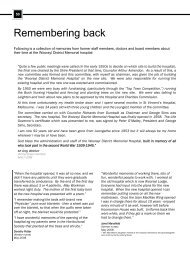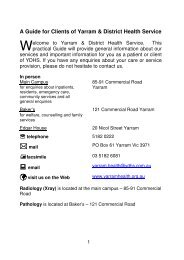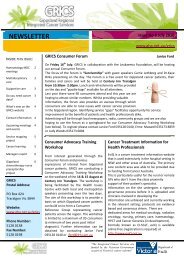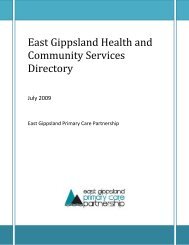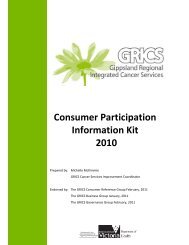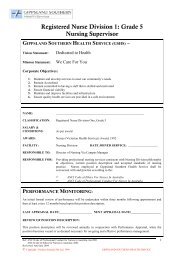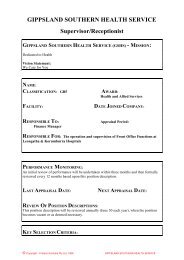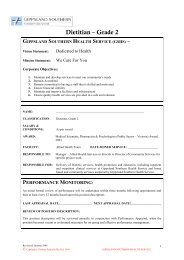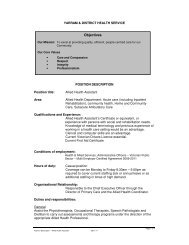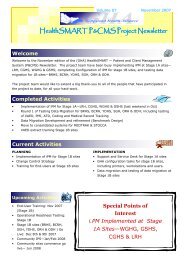Opioid Conversion Guidelines
Opioid Conversion Guidelines
Opioid Conversion Guidelines
Create successful ePaper yourself
Turn your PDF publications into a flip-book with our unique Google optimized e-Paper software.
<strong>Opioid</strong> <strong>Conversion</strong><br />
<strong>Guidelines</strong><br />
February 2011<br />
Gippsland Region<br />
Palliative Care Consortium<br />
Clinical Practice Group<br />
Policy No.<br />
Title<br />
Keywords<br />
Ratified<br />
GRPCC-CPG002_1.0_2011<br />
<strong>Opioid</strong> <strong>Conversion</strong> <strong>Guidelines</strong><br />
<strong>Opioid</strong>, <strong>Conversion</strong>, Drug, Therapy, Palliative,<br />
Guideline, Palliative, Care, Clinical, Practice<br />
GRPCC Clinical Practice Group<br />
Effective Date February 2011<br />
Review Date February 2013<br />
Purpose<br />
Acknowledgement<br />
This policy has been endorsed by the GRPCC<br />
Clinical Practice Group and is based on current<br />
evidence based practice and should be used to<br />
inform clinical practice, policies and<br />
procedures in health services. The intent of<br />
the policy is to promote region wide adoption<br />
of best practice. Enquiries can be directed to<br />
GRPCC by email GRPCC@gha.net.au<br />
Thanks to Southern Health & Calvary Health<br />
Care Bethlehem for providing this information<br />
Pages 4
Policy<br />
Statement<br />
Definitions<br />
Policy<br />
Equianalgesic dose conversions are necessary when changing opioid drug therapy in<br />
the clinical setting.<br />
<strong>Opioid</strong> analgesics vary in potency, side effect and pharmacokinetic profile. Therefore<br />
the <strong>Opioid</strong> <strong>Conversion</strong> <strong>Guidelines</strong> has been developed to assist when changing opioid<br />
drug therapy.<br />
PROCEDURE<br />
When rotating opioids for intolerable side effects or inadequate analgesia, it is<br />
advisable to reduce the dose of the new opioid by 25-50% due to incomplete crosstolerance.<br />
There should be adequate provision made for breakthrough medication and<br />
the patient should be monitored closely.<br />
Please note that all conversions in these guidelines are a guide only.<br />
Medication doses should be modified in response to the patients’ clinical<br />
condition and previous exposure to opioids.<br />
Oral to Oral<br />
Oral to Oral Ratio Example<br />
Oral Tramadol to Oral Morphine to 5:1 Oral Tramadol 50mg =Oral Morphine 10mg<br />
Oral Codeine to Oral Morphine 8:1 Oral Codeine 60mg = Oral Morphine 7.5mg<br />
Oral Morphine to Oral Methadone ? Complex pharmacology, discuss with Consultant.<br />
Dose requires to be titrated.<br />
Oral Morphine to Oral Oxycodone 1.5 : 1 Oral Morphine 15mg = Oral Oxycodone 10mg<br />
Oral Morphine to Oral Hydromorphone 5 : 1 Oral Morphine 5mg = Oral Hydromorphone 1mg<br />
Oral to Subcutaneous<br />
Oral to Subcutaneous Ratio Example<br />
Oral Morphine to SC Morphine 2-3 : 1 Oral Morphine 20-30mg = SC Morphine 10mg<br />
Oral Methadone to SC Methadone 1.5 : 1 Oral Methadone 20mg = SC Methadone 15mg<br />
Oral Hydromorphone to SC Hydromorphone 4 : 1 Oral Hydromorphone 4 mg =<br />
SC Hydromorphone 1mg<br />
Oral Oxycodone to SC Oxycodone 2 : 1 Oral Oxycodone 20mg = SC Oxycodone 10mg<br />
Subcutaneous to Subcutaneous<br />
Subcutaneous to Subcutaneous Ratio Example<br />
SC Morphine to SC Hydromorphone 5 : 1 SC Morphine 10mg = SC Hydromorphone 2mg<br />
SC Fentanyl to SC Sufentanil 10 : 1 SC Fentanyl 100mcg = SC Sufentanil 10mcg<br />
SC Morphine to SC Fentanyl 70-100 : 1 SC Morphine 10mg = SC Fentanyl 100-150mcg<br />
SC Morphine to SC Oxycodone 1-1.5 : 1 SC Morphine 10-15mg = SC Oxycodone 10mg<br />
<strong>Opioid</strong> <strong>Conversion</strong> <strong>Guidelines</strong><br />
GRPCC-CPG002_1.0_2011<br />
Gippsland Region Palliative Care Consortium Page 2 of 4
Subcutaneous to Subcutaneous Ratio Example<br />
IM Pethidine to SC Morphine 10 : 1 IM Pethidine 100mg= SC Morphine 10mg<br />
Subcutaneous to Other <strong>Opioid</strong> <strong>Conversion</strong>s<br />
Subcutaneous to Other Ratio Example<br />
SC or SL Fentanyl to TTS Fentanyl 1 : 1 Fentanyl 600mcg/24 hr CSCI = Fentanyl patch<br />
25mcg/hr<br />
SC Sufentanil to SL Sufentanil 1 : 1 Sufentanil 10mcg CSCI = Sufentanil SL 10mcg<br />
TTS = Transdermal Therapeutic System<br />
CSCI = Controlled Subcutaneous Infusion<br />
<strong>Opioid</strong> Patch & Equivalent Morphine / Oxycodone Doses<br />
Strength<br />
TTS<br />
Medication<br />
Delivery Rate<br />
(micrograms/hour)<br />
SC<br />
Morphine<br />
(mg/24<br />
hours)<br />
Oral<br />
Morphine<br />
(mg/24 hours)<br />
Oral<br />
Oxycodone<br />
(mg/24 hours)<br />
Durogesic 12 Fentanyl 12 10 - 20 20 - 60 15 - 40<br />
Durogesic 25 Fentanyl 25 30 - 40 60 - 100 40 - 70<br />
Durogesic 50 Fentanyl 50 60 - 80 120 - 200 80 - 140<br />
Durogesic 75 Fentanyl 75 90 - 120 180 - 300 120 - 200<br />
Durogesic 100 Fentanyl 100 120 - 160 240 - 400 180 - 270<br />
Norspan 5 Buprenorphine 5 9 - 13 5 - 10<br />
Norspan 10 Buprenorphine 10 18 - 26 10 - 20<br />
Norspan 20 Buprenorphine 20 36 - 53 25 – 40<br />
After application of the fentanyl patch peak plasma levels are achieved ~ 24 hours (significant plasma levels<br />
occur in 12 to 16 hours). Buprenorphine patch takes 3 days to achieve its steady state.<br />
On removal serum elimination half lives are: fentanyl 15 – 20 hours: buprenorphine 12 hours. Oral opiates should<br />
not be started until at least 12 hours following removal of either patch (excluding breakthroughs). Regular oral<br />
analgesia needs to be continued for 12-24 hours after commencing either patch.<br />
FORMULA for calculating SUFENTANIL Break-Through Doses (BTD) for a given Fentanyl Patch<br />
For a given Fentanyl Patch of x mcg/hr:<br />
BTD = x/5 micrograms of Sufentanil 2 hourly<br />
e.g. for Durogesic 25: BTD = 25/5 i.e 5 microgram Sufentanil 2 hourly<br />
Break-Through Doses should not exceed 40 micrograms Sufentanil<br />
Sufentanil is available as 250 mcg/5ml – i.e. 50 mcg/ml<br />
<strong>Opioid</strong> <strong>Conversion</strong> <strong>Guidelines</strong><br />
GRPCC-CPG002_1.0_2011<br />
Gippsland Region Palliative Care Consortium Page 3 of 4
Oral Analgesic Preparations<br />
Drug Trade Name Release Rate Usual Frequency Presentation<br />
Buprenorphine Temgesic Immediate Every 6-8 hours 200mcg tablets<br />
Fentanyl Transmucosal Actiq Immediate Every 2 -3 hours 200,400,600,<br />
800mcg lozenges<br />
Hydromorphone Dilaudid Immediate Every 2-3 hours 2,4,8mg tabs, 1mg/ml<br />
mixt<br />
Jurnista Slow Release Every 24 hours 8,16,32,64 mg tablets<br />
Methadone Physeptone Immediate Every 12 hours 10mg tablets, 5mg/ml<br />
mixt<br />
Morphine<br />
MS Contin Slow Release Every 12 hours 5, 10, 15, 30, 60, 100,<br />
200mg tab<br />
MS Contin<br />
Suspension<br />
Slow Release Every 12 hours 20, 30, 100mg sachet<br />
MS Mono Slow Release Every 24 hours 30, 60, 90, 120mg<br />
capsule<br />
Kapanol Slow Release Every 12-24 hours 10, 20, 50, 100mg<br />
capsule<br />
Anamorph Immediate Every 4-6 hours 30mg tablet<br />
Sevredol Immediate Every 4-6 hours 10, 20mg tablets<br />
Ordine Immediate Every 2-4 hours 1mg, 2mg,<br />
5mg,10mg/ml mixture<br />
Oxycodone<br />
OxyContin Slow Release Every 12 hours 5, 10, 20, 40, 80mg<br />
tablet<br />
Endone Immediate Every 4-6 hours 5mg tablet<br />
OxyNorm Immediate Every 4-6 hours 5, 10, 20mg capsule.<br />
5mg/5ml Liquid<br />
Tramadol<br />
Tramal/Zydol Immediate Every 4-6 hours 50mg tablet<br />
Tramal SR / Zydol<br />
SR<br />
Slow Release Every 12 hours 100mg, 150mg,<br />
200mg tablet<br />
References /<br />
Supporting<br />
Framework<br />
1. Analgesic Therapeutic <strong>Guidelines</strong>. Edition 4. Melbourne. 2002<br />
2. Palliative Care Therapeutic <strong>Guidelines</strong>. Edition 2. Melbourne 2005.<br />
3. Australian Medicines Handbook. 2007<br />
4. Product information. Mims [On-Line] Available: http://mims.hcn.net.au [2007,May]<br />
5. Palliative Care Formulary, www.palliativedrugs.com<br />
6. Narcotic analgesic, equianalgesic doses and pharmacokinetic comparison.<br />
7. Micromedex [On-Line] Available: http://micromedex.hcn.net.au [2007, May]<br />
8. <strong>Opioid</strong> <strong>Conversion</strong> Ratios – Guide to Practice 2010, Eastern Metropolitan Region<br />
Palliative Care Consortium. Melbourne 2010. Available online at:<br />
http://www.emrpcc.org.au/viewresources.asp?id=7 [2011, Feb)<br />
<strong>Opioid</strong> <strong>Conversion</strong> <strong>Guidelines</strong><br />
GRPCC-CPG002_1.0_2011<br />
Gippsland Region Palliative Care Consortium Page 4 of 4




